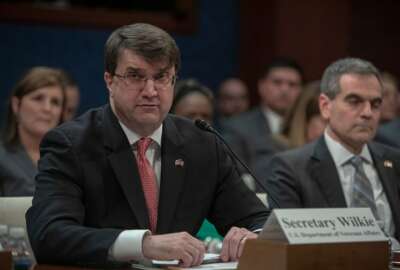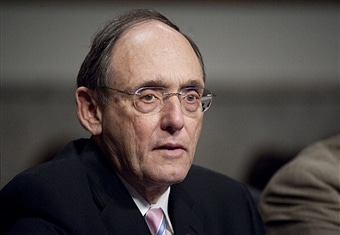

Congress is worried a 10-year, $2.5 billion financial management business transformation initiative is getting lost in the shuffle at the Department of Veterans...
Lawmakers are less than thrilled with the 10-year, $2.5 billion price tag for a financial management business initiative at the Department of Veterans Affairs, an effort that’s been more than 20 years in the making.
The project has largely flown under the radar, as VA’s massive 10-year, $16.5 billion electronic health record modernization efforts have taken center stage.
But whittling down the costs and timeline for the department’s financial management business transformation (FMBT) project will be tough, VA warned lawmakers, as the EHR and several other IT modernization initiatives have taken priority as well.
“The IT budget is stretched very thin with many new and costly requirements associated with the MISSION Act, [Forever GI] Act, the needed infrastructure upgrades and a seemingly endless list of system enhancements that improve services to veterans,” Jon Rychalski, VA’s chief financial officer and assistant secretary for management, told members of the House Veterans Affairs Committee at a hearing Thursday.
As VA modernization projects all compete for valuable IT dollars, implementation of these systems will, in some cases, depend on the success of the others.
VA’s current financial management system is 30 years old, and lawmakers said they were amazed the department had managed to scrape by with a passing grade on an annual audit.
Rychalski described the FMBT effort as a “high-risk, high-reward” initiative.
“Depending on how we do this if you were a VA medical center director, you could have an electronic record coming in. You could have a new logistics system coming in,” he said. “Depending on where we try to wedge ourselves in, you could have [FMBT] at the same time or just after — at a time when more veterans are coming to VA medical centers wanting more care, frankly.”
Like many of VA’s past IT overhauls, FMBT has a long, complex history. The department has twice tried to replace the system, first in 1998 and again in 2006, but both attempts failed.
VA later partnered with the Agriculture Department to purchase and implement CGI’s Momentum software for FMBT, but USDA canceled the shared services agreement back in 2017.
It reevaluated its options after the USDA loss and decided to continue on with its plan to implement the Momentum system.
“I’m uncomfortable with the fact that this program has changed dramatically and repeatedly since its inception,” Rep. Jack Bergman (R-Mich.), the subcommittee’s ranking member, said, pointing to a poster representing an FMBT schedule that was visually incomprehensible. “Since FMBT’s initiation the completion date has stretched from 2025 to 2028 to 2030. The number of implementation waves has increased from 18 to 33.”
The budget itself has also skyrocketed. When USDA was involved, the two agencies projected FMBT implementation at $887 million. But once USDA dropped out, costs for the project jumped to a little more than $1 billion.
The department said the scope and timeline associated with the project have changed for several reasons.
First, VA was forced to shoulder more of the IT burden once USDA dropped out of the project, Daniel McCune, executive director of VA’s Enterprise Portfolio Management Office, said.
“From an IT perspective, we are still recovering from that change of USDA leaving us,” he said. “We had a financial plan in place. When they left we had to restart the financial planning, and that’s a two-year cycle. We’re still catching up from that.”
Second, VA’s numerous modernization initiatives are all competing for IT funding and resources from the department’s Office of Information and Technology, the department said.
VA OI&T was supposed to contribute $14 million to the FMBT initiative, but members of Congress said that’s no longer the case.
“That may seem small,” Rep. Susie Lee (D-Nevada), chairman of the Veterans Affairs Subcommittee on Technology Modernization, said of the funding shortfall. “But it leads to strained decision-making, taking short cuts at early stages and not making the necessary investments to support the overall program.”
Finally, the costs and timeline for FMBT have shifted as VA and the Defense Department have made plans to update other integrated systems.
Beyond the new EHR, VA will also begin to deploy DoD’s medical logistics system, the Defense Medical Logistics Standard Support (DMLSS) program, next year. DoD itself plans to upgrade DMLSS to a cloud-based system, called LogiCole, in the near future, leaving VA to make a key decision about the timeline for its own adoption and integration with the FMBT.
“The accounting system must be tightly linked to the logistics system to ensure ordering, delivery and payments are seamless,” Rychalski said. “This presents a unique challenge in that if we deploy FMBT quickly, we will need to connect the financial system to the logistics system two separate times with two major training initiatives.”
By waiting, VA will be able to connect the new, cloud-based logistics system, Rychalski said. Still, the decision wasn’t an easy one.
“Faster deployment means more disruption to end-users, technical rework, cost and risk,” he said. “Slower deployment means it will take longer to get the full benefits of the FMBT system. None of us working on this program are satisfied with a 10-year deployment. The next year will be very telling with respect to accelerating our schedule.”
The electronic health record, the medical logistics system and the new financial management system are all supposed to achieve initial operating capability at various VA sites across the country in 2020.
Rychalski, who worked as a contractor on parts of previous iterations of VA’s financial management transformation efforts, said he was initially nervous about the FMBT plan when he first joined the department as its CFO in 2017.
He’s more confident today, he said, though 2020 will be key. VA’s National Cemetery Administration will go live with some FMBT capabilities at the same time.
“The big thing for us is proving that we can successfully deploy, training [and making sure] people can use it and that it has the functionality that we need,” Rychalski said. “That all is critically important … and we have to knock it out of the ballpark.”
Copyright © 2025 Federal News Network. All rights reserved. This website is not intended for users located within the European Economic Area.
Nicole Ogrysko is a reporter for Federal News Network focusing on the federal workforce and federal pay and benefits.
Follow @nogryskoWFED



